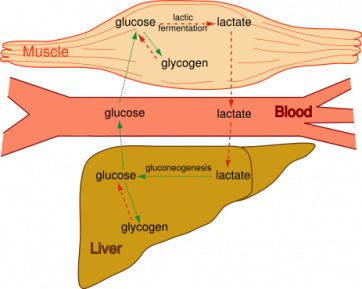Glycolysis:
Glycolysis involves the anaerobic catabolism of glucose.
This means that without oxygen, glycolysis catabolizes, or breaks down, glucose. This releases energy known as ATP(Adenosine Triphosphate). This release of ATP is vital for survival because it provides the energy for most energy consuming activites of the cell. This occurs in the cytosol in organisms whose cells contain a membrane bound nucleus (eukaryote). It then stores the free energy in 2 molecules of pyruvic acid.
In The Muscles:

Pyruvic acid is reduced by NADH forming a molecule of Lactic Acid. The process is called lactic acid fermentation. However, in the muscles the process can be debilitating because the lactic acid produced when they are strained is released into the blood causing a drop in pH.
In Mitochondria:
Pyruvic acid is oxidized completely, leaving only carbon dioxide and water.
This process is called Cellular Respiration, and approximately 40 percent of the energy in the original glucose molecule is trapped in molecules of ATP.
The Cori Cycle:
During muscle contrations, ATP is constantly being used to supply energy. Lactic acid is sent to the liver through the blood stream and converted into pyruvic acid. The pyruvic acid is converted to glucose through gluconeogenesis, and the glucose then can enter the blood and travel to the muscles for immediate use during exercise.
